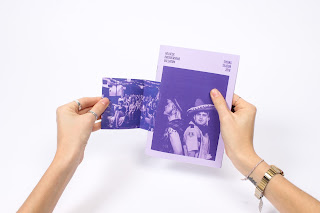Regarding the practical I am glad I changed my idea last minute to do a redesign for the Holbeck Underground Ballroom as it gave me an opportunity to create the visual identity from scratch, giving me creative freedom to apply everything I had written about in the essay, without the need to consider or be influenced by any pre-existing guidelines. That being said if I could have started the practical sooner, I would have liked to develop the visual identity further into environmental graphics such as wayfinding and street art, however, restricted by the time I wasn't able to do that. Unfortunately, I never saw the inside of the HUB as the Spring Season doesn't start until February and it has been closed all winter.
I'm still happy with the practical outcomes I designed as I effectively created a consistent visual identity that worked well across both printed, digital and promotional materials, as was discussed in my essay. I believe I have created a strong synthesis between the practical work and the essay referring to various designers and their principles across my design boards.
In terms of what I could have improved or explored further throughout this project, it would have been beneficial to get answers to the questions I emailed Apfel studio, the designers behind the Hepworth's visual identity on their opinions of the effects visual identity have on cultural institutions. However, I should have emailed a range of studios rather than putting all my eggs in one basket, to get a more diverse range of opinions.
I didn't do a questionnaire or test my design at the end of this project like I usually do for COP as I had done a number of crits throughout the process to determine the best route to take my designs. As the HUB had no visual identity system to begin with it wasn't a case of asking 'which do you prefer? Before or after?' as there was nothing to compare it to, so any outcome I created would have been an improvement.
Overall this final module for context of practice has really pushed me to the limit and tested my skills both in terms of writing, analysis, synthesising, conducting and extracting relevant research and designing an appropriate outcome. The overall content has been researched, developed and carried out to a standard I am proud of, with the constant feedback from my tutors and peers to ensure the project was going in the right direction. My final outcome demonstrates a range of collateral that is consistent and works effectively across both print and digital media, supported by an extensive body of research and development that builds upon the theoretical explorations of the written piece.
Overall this final module for context of practice has really pushed me to the limit and tested my skills both in terms of writing, analysis, synthesising, conducting and extracting relevant research and designing an appropriate outcome. The overall content has been researched, developed and carried out to a standard I am proud of, with the constant feedback from my tutors and peers to ensure the project was going in the right direction. My final outcome demonstrates a range of collateral that is consistent and works effectively across both print and digital media, supported by an extensive body of research and development that builds upon the theoretical explorations of the written piece.




















































